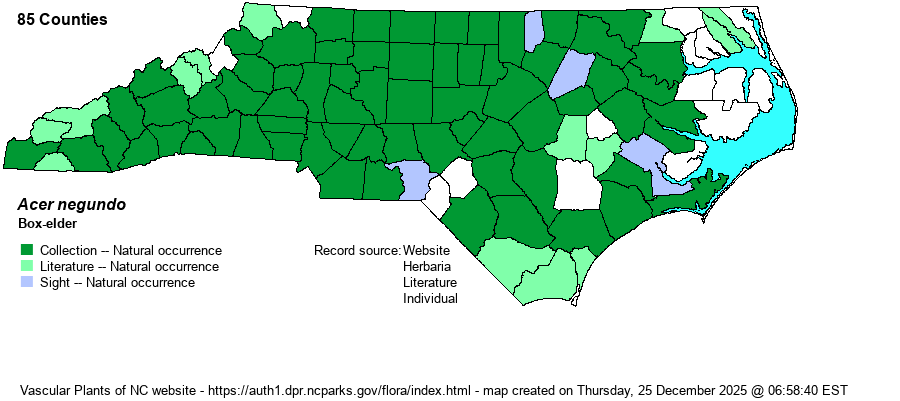| Author | L. | |
| Distribution | Throughout the Piedmont and essentially throughout the lower portions of the Mountains. Found over most of the western two-thirds of the Coastal Plain, but mainly along brownwater rivers. Certainly absent in a handful of far eastern counties – around Albemarle and Pamlico sounds.
This has one of the widest ranges of any plant, and especially a tree, in North America; it ranges across southern Canada south to central FL and the Mexico border. Absent mainly in the southern Great Plains and parts of the lower Atlantic Coastal Plain.
| |
| Abundance | Common in the Piedmont, lower Mountains, and along most brownwater river floodplains in the Coastal Plain. Scarce in the Mountains above perhaps 3000 feet, and also rare to occasional in many eastern counties, especially ones lacking a brownwater river (i.e., Meherrin, Roanoke, Tar, Neuse, and Cape Fear). | |
| Habitat | This is a characteristic tree of rich soil of bottomland hardwoods and natural levee forests. It also is found, less widely, in smaller stream bottom forests. It generally is not found in uplands, except where the soil is circumneutral or on roadside banks that cross a floodplain. It can also be found in some swampy grounds, as long as the soil is quite rich (close to circumneutral). | |
| Phenology | Flowers in March and April, and fruits from May to October. | |
| Identification | This is a well-known deciduous tree that looks like no others. It is a medium tree, growing to about 70 feet tall, and often is a bit of a successional species, being one of the first trees to colonize cleared bottomlands. It is the only maple with leaflets – mostly three, but some leaves have five or seven leaflets. Each leaflet is strongly toothed and elliptical in shape, and those with three leaflets look very similar to those of Poison-ivy (Toxicodendron radicans), a climbing vine or low shrub. The young twigs are a smooth, shiny bright yellow-green color. If you see three leaflets on a seedling or sapling, and you are not sure if the plant is Poison-ivy or Box-elder, look at the stem, as Box-elder has the bright green twigs with opposite leaves; Poison-ivy leaves are alternate, and the stems are dull brown. If in doubt, do not touch! | |
| Taxonomic Comments | Not surprisingly for such a broad-ranging species, a handful of varieties are named. The nominate variety – var. negundo – is the one that occurs nearly statewide and is confirmed for the state.
| |
| Other Common Name(s) | Ash-leaved Maple, Box-elder Maple | |
| State Rank | S5 | |
| Global Rank | G5 | |
| State Status | | |
| US Status | | |
| USACE-agcp | FAC link |
| USACE-emp | FAC link |

